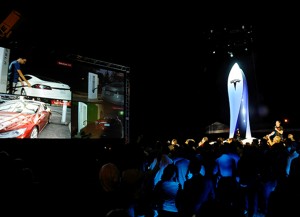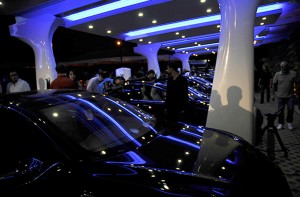Critics of electric vehicles always point to their limited usefulness for long-distance travel. With many EVs having a range of 80 miles, what do you do if you need to go more than 40 miles from home? And where will you plug it in?
Tesla Motors may have an answer. Constructed in secrecy, Tesla unveiled plans for the first six “Supercharger” stations in California. Eventually, Tesla plans to build a network of 100 of the stations across the country.
Just in case you’re planning to take your Nissan Leaf or Chevrolet Volt – or even Tesla’s first model, the Roadster – to one of the stations, don’t bother. The Superchargers will only work on the Tesla Model S, the carmaker’s new all-electric sedan, and only models with the optional hardware package that allows them to use the system.
Best of all for the green crowd, the Superchargers will be powered solar panels that will actually send excess electricity back to the grid. Model S owners will be able to use the charging stations for free.
Tesla CEO Elon Musk announced the Supercharger network at a gala event in Los Angeles.
“By making electric long distance travel at no cost, an impossibility for gasoline cars, Tesla is demonstrating just how fundamentally better electric transport can be,” Musk said. “We are giving Model S the ability to drive almost anywhere for free on pure sunlight.”
Still, the Supercharger system is not without controversy.
Tesla said that the Supercharger will provide cars with 85 kWh battery pack with about 150 miles of driving range after charging for just 30 minutes. The charging stations will be located near eateries and shopping malls so motorists can take a break before heading back on the road.
Next year, the company will install Superchargers along corridors between Vancouver and San Diego, Miami to Montreal and Los Angeles to New York. The company will begin installing Superchargers in Europe and Asia in the second half of 2013.
Click here to read an in-depth look at Tesla’s June launch.
But some Tesla fans filled chat boards and Tesla’s facebook page with concerns that multiple quick charges would damage the car’s battery pack, a common concern expressed by other electric vehicle experts.
Tesla insisted that its battery will suffer no ill effects from multiple fast charging cycles.
Also controversial is Tesla’s decision to leave buyers of its base model out of the Supercharging party. The hardware and software needed to use the Superchargers is standard on the $69,900 model with 85kWh battery and will be optional on the $59,900 model with the 60kWh battery, when it is released (although the model pricing area of the website says it is standard on the 60kWh model as well). But it won’t be available on the base $49,900 model with a 40kWh battery.
Tesla says the top model has a 300-mile range, although the EPA puts it at 265. It claims a 230-mile range for the mid-level 60kWh model and 160 miles for the entry-level S.
Some also questioned if the solar arrays, which will be installed on the canopies covering the charging stations, will have enough capacity to charge multiple Teslas at the same time.
Controversies aside, the charging network begins to show how EVs might work for long-distance travel, range anxiety be damned.


